Virtual reality tours can transport you to different times and places without ever leaving your home. One of the most fascinating destinations to explore through virtual reality tours is ancient Rome. With the help of advanced technology, you can now discover the wonders of this ancient civilization in a way that was never before possible.
The virtual reality tours of ancient Rome offer a glimpse into daily life and culture during the height of the Roman Empire. You can explore the Colosseum, the Forum, and other historic landmarks and get a sense of what it was like to live in ancient Rome. With the ability to move around and interact with the environment, virtual reality tours provide a level of immersion that is unmatched by traditional history books or documentaries.
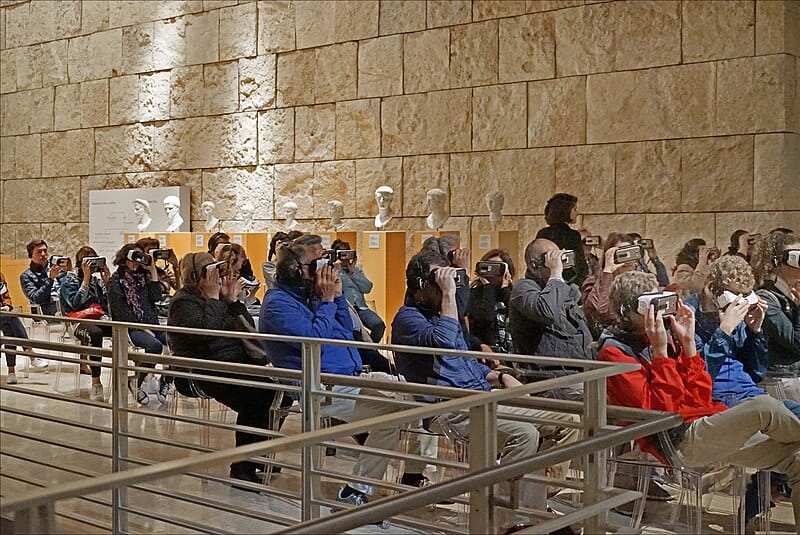
Source: Jean-Pierre Dalbéra from Paris, France, CC BY 2.0 https://creativecommons.org/licenses/by/2.0, via Wikimedia Commons
If you’re interested in exploring ancient Rome through virtual reality, there are several tours available that offer an in-depth look at this fascinating period in history. These tours are designed to be informative and engaging and can be enjoyed by anyone with an interest in history or technology. Whether you’re a student, a history lover, or just looking for a unique way to explore the past, virtual reality tours of ancient Rome are an experience not to be missed.
Key Takeaways
- Virtual reality tours provide an immersive experience that can transport you to different times and places.
- Ancient Rome is a fascinating destination to explore through virtual reality tours, offering a glimpse into daily life and culture during the height of the Roman Empire.
- Virtual reality tours of ancient Rome are informative and engaging and can be enjoyed by anyone with an interest in history or technology.
The Evolution of Virtual Reality Tours
Virtual reality (VR) technology has revolutionized the way people experience historical sites. It provides an immersive experience that allows users to explore ancient Rome as if they were actually there. The evolution of virtual reality tours has come a long way since its inception. Today, there are numerous virtual reality tours available that take users on a journey through ancient Rome.
From 3D Reconstructions to Immersive VR
The development of 3D reconstruction technology has played a significant role in the evolution of virtual reality tours. 3D reconstruction technology allows archaeologists and historians to create digital reconstructions of ancient sites. These digital reconstructions can then be used to create virtual reality tours that provide users with an immersive experience of ancient Rome.
Technological Advancements in VR
Advancements in virtual reality technology have also played a significant role in the evolution of virtual reality tours. The development of more powerful and affordable VR headsets has made it possible for more people to experience virtual reality tours.
Exploring the Wonders of Ancient Rome
Virtual reality technology has revolutionized the way we explore ancient Rome. With the help of VR headsets, users can now immerse themselves in the ancient world and experience the grandeur of the Roman Empire from the comfort of their own homes.
Colosseum: A Virtual Journey
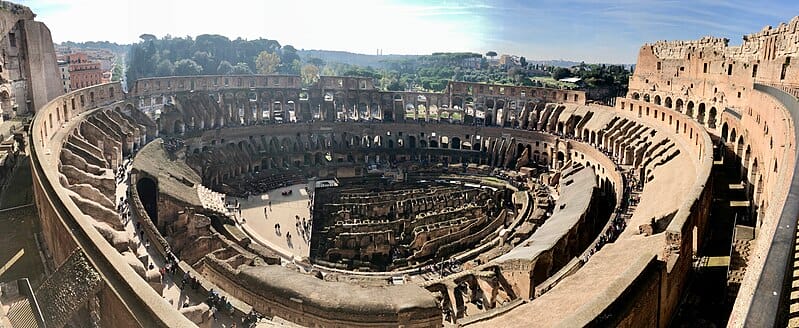
The Colosseum is one of the most iconic landmarks of ancient Rome and a must-see for anyone interested in Roman history. With the Colosseum virtual reality tour, users can step back in time and experience what it was like to be a gladiator in ancient Rome. The tour takes users through the various levels of the Colosseum, from the underground tunnels where gladiators prepared for battle to the upper levels where the Emperor and other VIPs watched the games.
Arena Level: Users can walk through the arena floor where gladiatorial contests and other spectacles have taken place. This section of the tour recreates the vibrancy of the Colosseum’s events, complete with the roar of the crowd and the clashing of gladiators. The immersive environment lets users feel the excitement and tension of the games.
Underground Chambers: The tour delves into the hypogeum, the intricate network of underground tunnels and rooms that housed gladiators, animals, and stage machinery. Users can explore these hidden areas, gaining insight into the logistical aspects of the games and the preparations involved.
Upper Tiers: Virtual visitors can ascend to the upper levels of the Colosseum, offering panoramic views of the arena below and the surrounding cityscape of Ancient Rome. This vantage point helps users appreciate the scale of the amphitheater and the grandeur of the Colosseum’s architecture.
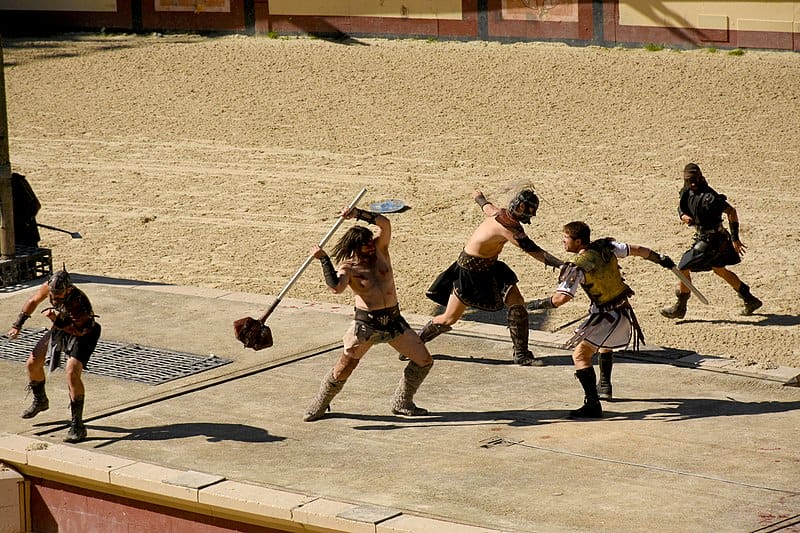
Source: Amaury Laporte, CC BY 2.0 https://creativecommons.org/licenses/by/2.0, via Wikimedia Commons
Circus Maximus and the Chariot Races
The Circus Maximus was the largest stadium in ancient Rome and was used for chariot races and other public events. With the Circus Maximus virtual reality tour, users can experience the thrill of the chariot races and explore the stadium as it would have looked in ancient times. The tour also provides a glimpse into the daily life of the people of ancient Rome and the importance of public entertainment in Roman culture.
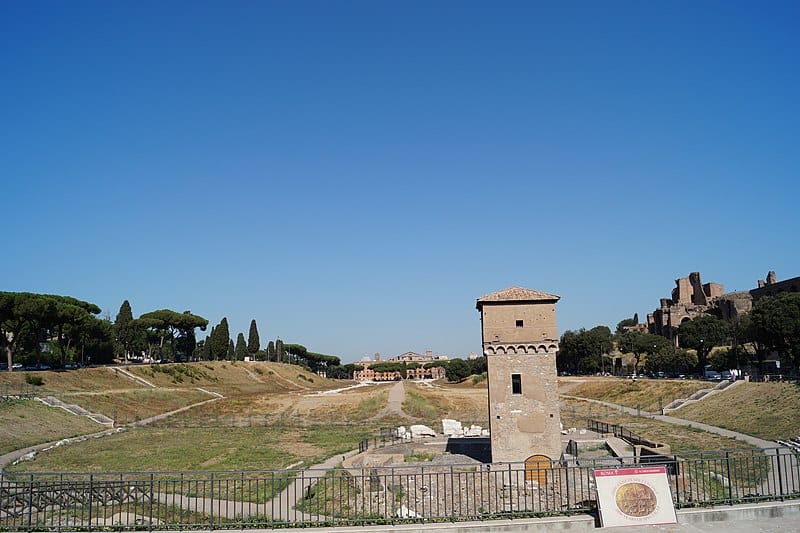
Source: ScienceCheese, CC BY 3.0 https://creativecommons.org/licenses/by/3.0, via Wikimedia Commons
Arena Layout: Users can explore the vast oval arena, which could accommodate up to 250,000 spectators. The VR tour accurately recreates the seating tiers, the starting gates, and the central spina – a barrier around which chariots raced. This detailed representation helps users appreciate the sheer scale of the Circus Maximus and the organization required to host such massive events.
Chariot Races: The experience allows users to virtually participate in or watch the thrilling chariot races that were the centerpiece of Circus Maximus events. The VR simulation captures the speed and intensity of the races with realistic sound effects and visual details that make users feel as though they are right there in the middle of the action.
Spectator Experience: Users can also get a sense of what it was like for spectators, including the cheering crowds, the grandeur of the arena, and the elaborate decorations that adorned the Circus Maximus for major events.
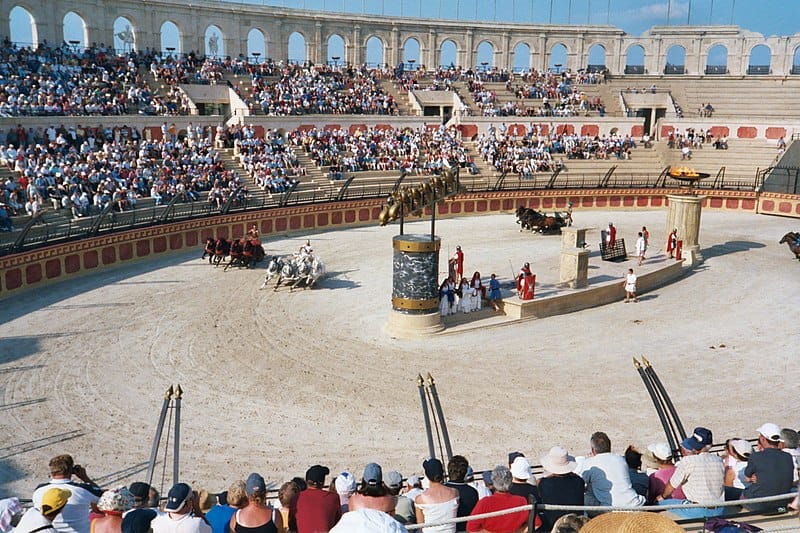
The Roman Forum: Heart of Public Life
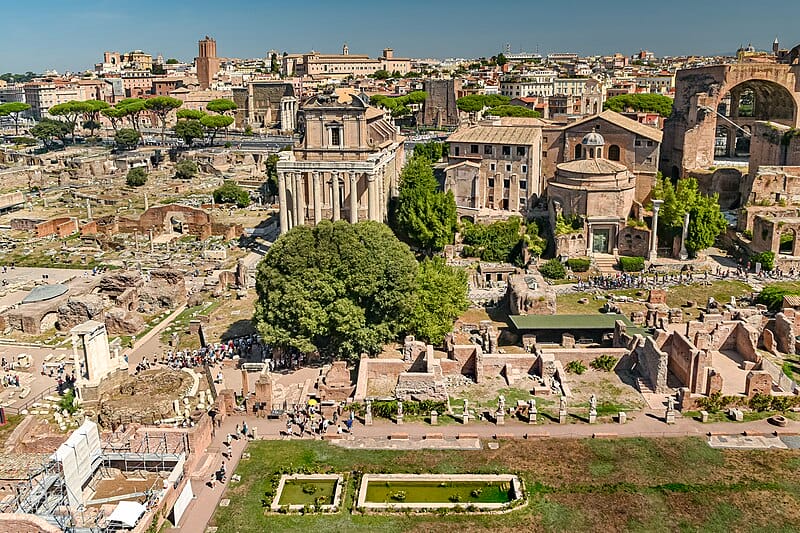
Source: Jorge Franganillo, CC BY 2.0 https://creativecommons.org/licenses/by/2.0, via Wikimedia Commons
The Roman Forum was the center of political and social life in ancient Rome and was home to some of the most important buildings and monuments of the Roman Empire. With the Roman Forum virtual reality tour, users can explore the ruins of the Forum and learn about the history and significance of each building. The tour also provides a glimpse into the daily life of the people of ancient Rome and the role that the Forum played in their lives.
Historical Reconstruction: The VR tour provides a meticulously reconstructed view of the Roman Forum as it appeared during its peak. Users can navigate through the various buildings and structures, such as the Temple of Saturn, the Arch of Titus, and the Basilica Julia. The detailed virtual environment recreates the architectural splendor and layout of the Forum, allowing users to appreciate its scale and design.
Interactive Features: The experience often includes interactive elements that enable users to learn more about specific sites and structures. For example, users might be able to click on different buildings to access historical information, view artistic renditions of how the Forum looked in its prime, or hear detailed explanations about the significance of various monuments.
Panoramic Views: The tour provides sweeping panoramic views of the Forum, allowing users to see the entire complex from different vantage points. This feature helps users understand the spatial relationships between the different structures and the overall layout of the Forum.

Source: Bradley Weber, CC BY 2.0 https://creativecommons.org/licenses/by/2.0, via Wikimedia Commons
A Glimpse into Daily Life and Culture
Ancient Rome was a hub of culture and daily life that is still fascinating to explore today. Virtual reality tours offer a unique opportunity to experience the sights and sounds of this ancient city. Here are two must-see destinations that give a glimpse into the daily life and culture of ancient Rome.
Domus Aurea: Nero’s Golden House
The Domus Aurea, or Nero’s Golden House, was an extravagant palace built by Emperor Nero in the first century AD. The palace was decorated with intricate frescoes, mosaics, and sculptures, and was known for its opulence and extravagance. Virtual reality tours of the Domus Aurea allow visitors to explore the palace’s many rooms and halls, and to see the incredible artwork that adorned its walls and ceilings.
Users can explore the palace and its stunning frescoes as they would have looked in ancient times. The tour takes users through the various rooms of the palace, including the famous Octagonal Room, and provides a glimpse into the opulence and extravagance of the Roman Empire.
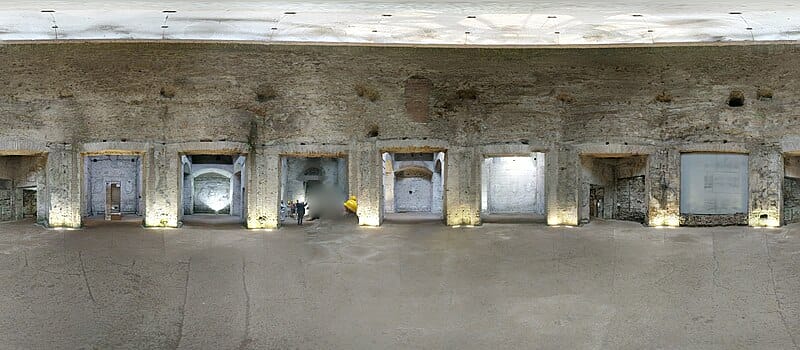
Source: Tyler Bell, CC BY 2.0 https://creativecommons.org/licenses/by/2.0, via Wikimedia Commons
Architectural Marvels: The VR tour recreates the grandeur of the Domus Aurea, showcasing its vast halls, lavish rooms, and intricate designs. Users can virtually walk through the palace’s expansive corridors, view the opulent frescoes, and marvel at the innovative use of space and light. The experience highlights key features such as the octagonal hall, which was a pioneering design in its time.
Interactive Features: The tour often includes interactive elements that allow users to delve deeper into specific aspects of the Domus Aurea. For example, users can click on different rooms to learn more about their purpose, view artistic reconstructions of the palace’s original decorations, and access detailed explanations about the architectural techniques used.
Restoration and Visualization: One of the standout features of the VR experience is its ability to visualize the Domus Aurea as it might have appeared during Nero’s reign. The tour includes reconstructions of the palace’s frescoes and decorative elements based on historical research, providing users with a vivid sense of the palace’s original splendor.
Baths of Caracalla: A Social Hub
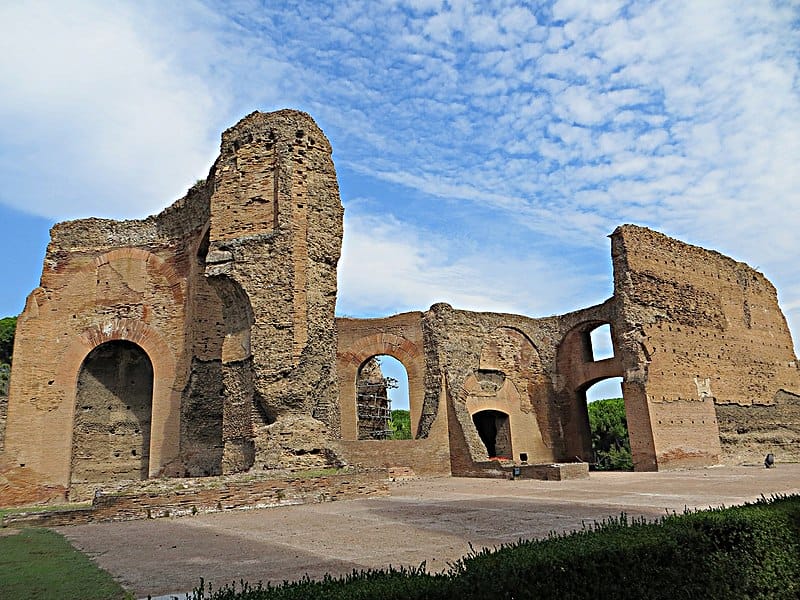
Source: Mister No, CC BY 3.0 https://creativecommons.org/licenses/by/3.0, via Wikimedia Commons
The Baths of Caracalla were one of the largest and most impressive public baths in ancient Rome. Built in the early third century AD, the baths were a social hub for the city’s residents and were frequented by people from all walks of life. Virtual reality tours of the Baths of Caracalla allow visitors to explore the different areas of the complex, including the caldarium (hot bath), tepidarium (warm bath), and frigidarium (cold bath). Visitors can also see the intricate mosaics and sculptures that adorned the baths, and get a sense of what daily life was like for the ancient Romans.
Frigidarium (Cold Room): Users can explore the frigidarium’s vast space, complete with its high vaulted ceilings and intricate floor mosaics. The experience highlights the architectural design, including the impressive scale of the cold pool and the surrounding decorative elements. Users can interact with the virtual environment to learn more about how the frigidarium functions and its role in the bathing routine.
Tepidarium (Warm Room): This tour allows users to explore the tepidarium’s elegant design, including its warm, inviting atmosphere and comfortable seating areas. Users can view the detailed mosaic floors, the architectural elements such as columns and arches, and the innovative heating systems that maintain the room’s warmth. The interactive features provide insights into how the tepidarium was used as a space for relaxation and social interaction.
Caldarium (Hot Room): The tour vividly reconstructs the Caldarium’s luxurious setting, including the large hot pool, the heated walls and floors, and the impressive dome ceiling. Users can explore the detailed architecture and learn about advanced heating systems, such as the hypocaust (underfloor heating) that keeps the room at a high temperature. The tour emphasizes the sensory experience of the caldarium, providing a sense of the heat and steam that bathers would have encountered.
Prices:
- Basic Tour: Generally priced between €25 and €35, this option includes access to the main areas and a general overview of features and history.
- Enhanced Experience: For €40 to €50, users can access additional features such as extended tours of specific areas, more detailed interactive elements, and enhanced historical commentary.
- Premium Packages: Premium options, costing around €60, often include exclusive features like guided tours by experts, in-depth educational content, and personalized experiences.
People Also Ask:
What are the top-rated virtual reality tours for exploring ancient Rome?
There are several top-rated virtual reality tours available for exploring ancient Rome. Some popular options include “Rome Reborn,” “Ancient Rome VR,” and “The Rome Experience.” These tours offer immersive experiences that allow users to explore the ancient city in 3D and learn about its history and culture.
Can you experience ancient Rome through VR on the Oculus Quest?
Yes, the Oculus Quest is a popular VR headset that can be used to experience ancient Rome through various virtual reality tours. Many of the top-rated tours are compatible with the Oculus Quest, allowing users to explore the city in a fully immersive way.
Are there any free virtual reality tours available for ancient Rome?
Yes, there are several free virtual reality tours available for ancient Rome. Some popular options include “Rome Reborn,” which offers a free demo version, and “Ancient Rome VR,” which is available for free on the Steam platform.
What historical sites are featured in virtual reality tours of ancient Rome?
Virtual reality tours of ancient Rome typically feature a wide range of historical sites, including the Colosseum, the Roman Forum, the Pantheon, and the Circus Maximus. Users can explore these sites in 3D and learn about their history and significance.
How does the Rome time travel experience utilize Virtual Reality Tours and VR technology?
The Rome time travel experience is a virtual reality tour that allows users to travel back in time and explore ancient Rome. The tour utilizes VR technology to create an immersive experience that transports users to the ancient city and allows them to interact with historical figures and objects.
What can you learn about the Roman Forum through virtual reality tours?
Virtual reality tours of the Roman Forum offer users the opportunity to explore this ancient site in 3D and learn about its history and significance. Users can view the Forum from various angles and perspectives and can learn about the political and social events that took place there during ancient times.
Hello, my name is Vladimir, and I am a part of the Roman-empire writing team.
I am a historian, and history is an integral part of my life.
To be honest, while I was in school, I didn’t like history so how did I end up studying it? Well, for that, I have to thank history-based strategy PC games. Thank you so much, Europa Universalis IV, and thank you, Medieval Total War.
Since games made me fall in love with history, I completed bachelor studies at Filozofski Fakultet Niš, a part of the University of Niš. My bachelor’s thesis was about Julis Caesar. Soon, I completed my master’s studies at the same university.
For years now, I have been working as a teacher in a local elementary school, but my passion for writing isn’t fulfilled, so I decided to pursue that ambition online. There were a few gigs, but most of them were not history-related.
Then I stumbled upon roman-empire.com, and now I am a part of something bigger. No, I am not a part of the ancient Roman Empire but of a creative writing team where I have the freedom to write about whatever I want. Yes, even about Star Wars. Stay tuned for that.
Anyway, I am better at writing about Rome than writing about me. But if you would like to contact me for any reason, you can do it at contact@roman-empire.net. Except for negative reviews, of course. 😀
Kind regards,
Vladimir
